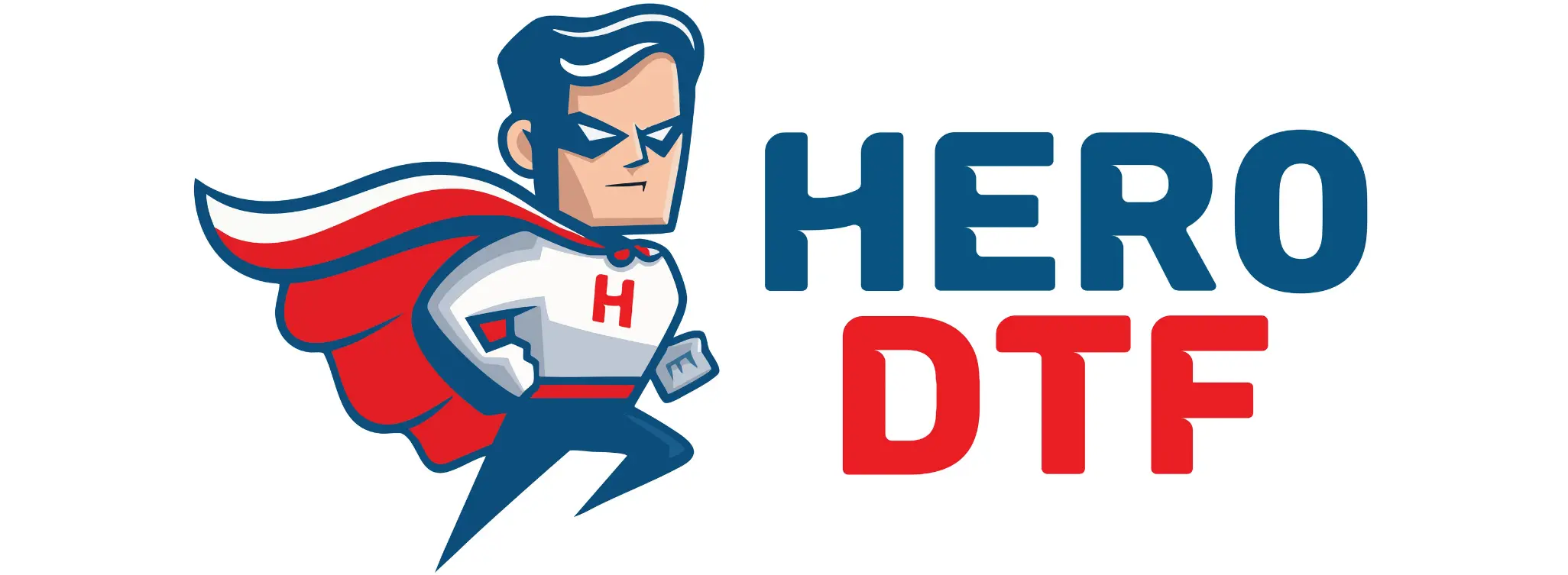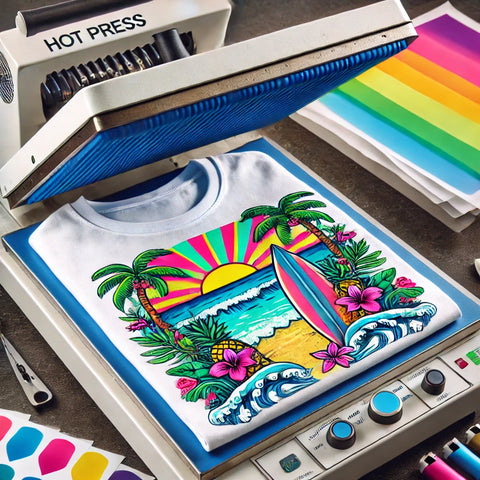When investing in custom apparel, one of the first questions that comes to mind is: "How durable is the design?" Direct-to-Film (DTF) transfers have become a popular choice for vibrant and versatile prints, but how long can you expect them to last? The answer isn’t as straightforward as you might think, and it depends on several key factors.
From the quality of the transfer materials to how you care for your garments, every detail plays a role in determining the lifespan of a DTF print.
So, how long do DTF transfers actually last? With proper care and the use of high-quality materials, DTF prints can withstand 50 or more washes without significant degradation in quality. This means your favorite custom t-shirt, hoodie, or bag can remain vibrant and intact for several years of regular use. Imagine wearing your favorite custom t-shirt for years without the design fading or cracking—sounds ideal, right? And with DTF transfers, it’s entirely possible.
In this article, we’ll uncover the secrets to maximizing the longevity of DTF transfers. Whether you're a business owner or simply a fan of personalized apparel, understanding these factors can help you get the most out of your designs. Keep reading to learn how to make your prints last longer than you ever expected!
Understanding Durability
Durability is the measure of how well a product can resist wear and tear over time. In terms of DTF transfers, it indicates how long the printed design remains intact and visually appealing despite frequent use and washing. A durable design retains its color vibrancy and adhesion, ensuring that the garment looks fresh and new even after numerous washes. Understanding durability helps consumers make informed choices about the longevity and value of their custom apparel.
Are DTF Transfers Durable?
DTF (Direct-to-Film) transfers are known for their impressive durability, often outperforming traditional printing methods in terms of longevity. The key to their resilience lies in the specialized inks and films used in the process, which create a robust bond with the fabric. This bond ensures that the design remains vibrant and intact through numerous washes, maintaining its original appearance. Additionally, the flexibility of DTF prints allows them to stretch with the fabric without cracking, further enhancing their durability.
However, the true lifespan of a DTF transfer also depends on how the garment is cared for. Proper washing and drying techniques play a crucial role in preserving the print. For example, turning the garment inside out before washing, using cold water, and avoiding harsh detergents can significantly extend the life of the transfer. By following these care instructions, DTF transfers can remain vibrant and durable, providing long-lasting satisfaction for those who choose this printing method.
What Affects the Durability of DTF Transfers?
The durability of DTF transfers depends heavily on the quality of materials used in the printing process. High-quality transfer films and inks create a stronger bond with the fabric, ensuring that the design remains vibrant and intact even after repeated washes. Low-quality materials, on the other hand, may lead to fading, cracking, or peeling over time. This makes choosing reliable suppliers and premium products critical for achieving long-lasting results.
Another significant factor is the type of fabric the design is applied to. Smooth, high-quality fabrics, such as cotton or polyester blends, tend to provide better adhesion for DTF transfers. Rough or textured fabrics might not bond as effectively with the transfer, increasing the likelihood of wear and tear. Additionally, the stretchiness of the material can impact durability—fabrics that stretch too much may cause the transfer to crack or distort over time.
Lastly, garment care plays a crucial role in how long a DTF transfer lasts. Washing the garment in cold water, avoiding bleach or harsh detergents, and air-drying instead of using a tumble dryer can significantly extend the life of the print. Turning the garment inside out before washing is another simple yet effective way to protect the design. Proper care ensures that the transfer remains vibrant and intact, allowing you to enjoy your custom apparel for years to come.
How Does the Lifespan of DTF Transfers Vary Based on Materials?
The longevity of DTF transfers is significantly influenced by the quality of materials used during the printing and application process. High-quality transfer films, inks, and adhesives not only ensure vibrant and detailed prints but also enhance durability over time. Conversely, using lower-quality materials can lead to issues such as fading, cracking, or peeling after just a few washes. Investing in premium materials is crucial for achieving long-lasting results, especially for items that will be washed and worn frequently.
Here are the key material factors that affect the lifespan of DTF transfers:
-
Transfer Film Quality: High-quality films provide better ink adhesion and flexibility, reducing the risk of cracking or peeling.
-
Ink Quality: Premium inks resist fading and maintain vibrant colors even after multiple washes.
-
Adhesive Powder: A strong, high-quality adhesive ensures the design bonds securely to the fabric, improving durability.
-
Fabric Type: Natural fibers like cotton tend to hold DTF prints better than synthetic fabrics, which may require special treatments for optimal results.
-
Printer and Equipment: Using professional-grade printers and heat presses ensures consistent application and better durability.
-
Environmental Resistance: Some materials include UV-resistant inks or coatings that protect against sunlight and environmental wear.
By choosing the right combination of these materials, you can significantly extend the lifespan and quality of your DTF prints, ensuring they remain vibrant and durable for years to come.
Fabric Type and DTF Print Longevity
The type of fabric used plays a critical role in determining how long a DTF print will last. Different fabrics interact with the adhesive and ink in unique ways, which can either enhance or reduce the durability of the design. While DTF transfers are versatile and work on a wide range of materials, the lifespan of the print can vary depending on the fabric type and its properties.
Here’s how fabric type impacts the lifespan of DTF prints:
Cotton (100%):
-
DTF prints last the longest on 100% cotton fabrics, often maintaining their quality for 50+ washes with proper care. Cotton provides an excellent surface for ink adhesion, ensuring vibrant and durable designs over time.
Polyester (100%):
-
Polyester fabrics are also compatible with DTF prints, but the lifespan may be slightly shorter than cotton due to the fabric's smoother surface, which can sometimes reduce ink bonding. On polyester, prints can typically last around 40-50 washes.
Cotton-Polyester Blends:
-
Blended fabrics (e.g., 50/50 cotton-polyester) offer a good balance of durability and comfort. DTF prints on blended fabrics can last approximately 40-50 washes, depending on the blend ratio and care practices.
Nylon:
-
Nylon fabrics are more challenging for DTF prints due to their slick and stretchy nature. While possible, prints on nylon may last for around 30-40 washes with proper care, but they are more prone to peeling or cracking over time.
Spandex or Lycra:
-
Stretchy fabrics like spandex or lycra are less ideal for DTF printing. The constant stretching of the material can cause the print to crack or peel more quickly, typically lasting around 20-30 washes.
Denim:
-
DTF prints on denim can last for around 40-50 washes, as the fabric's sturdy texture allows for good ink adhesion. However, frequent washing or harsh detergents can wear down the design faster.
By choosing the right fabric and following proper care instructions, you can maximize the lifespan of DTF prints and ensure your designs stay vibrant and intact for as long as possible.

Environmental Factors and Their Impact on DTF Transfer Durability
The durability of DTF printed items is heavily influenced by environmental conditions. Elements like sunlight, humidity, and temperature fluctuations play a significant role in the longevity of your prints. Prolonged exposure to direct sunlight can cause colors to fade over time, diminishing the vibrancy of the design. Similarly, high humidity or extreme temperature changes can weaken the bond between the ink and fabric, leading to peeling or cracking. To ensure your DTF prints last longer, it’s crucial to consider the environment in which they are used or stored.
For example, keeping DTF printed items out of direct sunlight can significantly reduce the risk of fading. If the items are displayed or stored in areas with high sunlight exposure, using UV-protective covers or placing them in shaded spaces can help mitigate damage. Additionally, maintaining a stable temperature and avoiding excessively humid conditions can preserve the integrity of the print. High moisture levels can compromise the adhesion of the ink, so storing items in a cool, dry place is essential for long-term durability.
Proper storage practices are equally important for protecting your DTF prints from environmental damage. Wrapping items in acid-free tissue paper before placing them in storage boxes can prevent abrasion or unwanted color transfer. Choosing a dark, dry, and temperature-controlled storage location will further safeguard the vibrancy and quality of your designs. While it may not always be possible to control every aspect of the environment, these simple precautions can make a big difference in extending the life of your DTF printed products, ensuring they remain vibrant and eye-catching for years to come.
👉 Get vibrant, long-lasting results with DTF Transfers By Size—precision-made for every project, big or small. Order now from Hero DTF!
How Can Durability Be Maximized?
Maximizing the durability of DTF transfers starts with proper washing and care instructions. One of the simplest yet most effective steps is to turn the garment inside out before washing. This reduces direct friction between the printed design and other clothes or the washing machine drum, helping to prevent peeling or cracking. Additionally, always use cold water for washing, as hot water can weaken the adhesive bond and cause the print to fade over time.
Another important factor is the choice of detergent. Harsh detergents or those containing bleach can damage the fabric and the DTF transfer, leading to fading or discoloration. Opt for mild, color-safe detergents to ensure the print stays vibrant. It’s also a good idea to avoid fabric softeners, as they can create a residue that affects the longevity of the transfer.
Drying the garment properly is just as crucial as washing. Air-drying is the best option, as tumble dryers expose the fabric to high heat, which can cause the adhesive to weaken and the design to crack. If you must use a dryer, choose a low heat setting and remove the garment promptly. By following these washing and care instructions, you can significantly extend the life of your DTF transfers and keep them looking fresh for a long time.
How to Wash DTF Printed Products?
Proper washing and care methods are essential to ensure the longevity of DTF-printed products. Incorrect washing practices can cause the print to fade, crack, or peel. Here are the key points to follow when washing DTF-printed items.
Further FAQs
Can DTF transfers be ironed?
Yes, DTF transfers can be ironed, but it should be done carefully. To avoid damaging the design, place a protective layer (such as parchment paper or a thin cloth) over the transfer before ironing. Use a low to medium heat setting and avoid direct contact between the iron and the transfer. This will help preserve the quality and prevent peeling or cracking.
Can garments with DTF transfers be dry cleaned?
No, DTF transfers are not recommended for dry cleaning. The chemicals and high heat used in the dry cleaning process can damage the transfer, causing it to peel, crack, or lose its vibrancy. It is best to stick to gentle machine washing or hand washing to maintain the quality of the design.
Are DTF transfers prone to cracking or peeling?
When properly applied and cared for, DTF transfers are highly durable and resistant to cracking or peeling. However, issues can occur if the transfer is not applied correctly (e.g., incorrect temperature or pressure) or if the garment is washed and dried at high temperatures. Following the recommended care instructions, such as washing in cold water and avoiding high heat, will help maintain their quality.
Can DTF transfers be applied to any fabric?
DTF transfers work best on cotton, polyester, and cotton/poly blends. However, they may not adhere well to fabrics with a water-repellent or very stretchy surface.
Are DTF transfers eco-friendly?
DTF transfers are considered more eco-friendly than some other methods because they produce less waste and require fewer chemicals during production.
Can DTF transfers be stretched?
Yes, DTF transfers are flexible and can be stretched slightly without cracking or peeling, as long as they are applied correctly and to the right type of fabric.
Are DTF transfers waterproof?
Yes, DTF transfers are waterproof and can withstand washing without losing their quality, as long as proper care instructions are followed.
Do DTF transfers require pre-treatment on fabrics?
No, unlike some other methods like DTG (Direct-to-Garment), DTF transfers do not require pre-treatment on fabrics, making the process faster and easier.
DTF Transfers: The Final Word
And there you have it – everything you need to know about DTF transfers, their longevity, and the best ways to maintain them. The key to achieving durable, eye-catching designs is a combination of premium materials, precise application techniques, and proper garment care. With these insights, you’re ready to dive into the world of DTF printing and produce high-quality designs that will leave a lasting impression on both you and your customers. Happy printing!
Ready to Make Your Prints Last? Choose Hero DTF.
At Hero DTF, we don’t just print — we deliver vibrant, long-lasting designs that stand the test of time. Whether you're creating custom apparel for your brand, your team, or your passion project, our premium materials and expert craftsmanship ensure your prints stay bold and brilliant wash after wash.
- High-Quality DTF Transfers
- Fast Turnaround Time
- Wholesale & Custom Orders Available
👉 Order now at Hero DTF and see why we’re New Jersey’s #1 source for top-tier DTF transfers.




